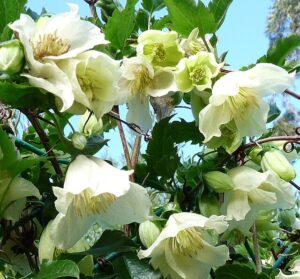 In my part of the world, snow is on the menu for today, and the first few flakes of an expected four to six inch accumulation are swirling down from above. In the house, a couple of last year’s amaryllis plants are flowering, in the company of a reblooming kalanchoe. The blue butterfly bush, Clerodendron ugandense, inside for its winter sleepover, is producing a handful of lovely sky blue butterfly-shaped flowers. This is enough floral inspiration to sustain my soul for right now, but, like all gardeners, I dream of spring.
In my part of the world, snow is on the menu for today, and the first few flakes of an expected four to six inch accumulation are swirling down from above. In the house, a couple of last year’s amaryllis plants are flowering, in the company of a reblooming kalanchoe. The blue butterfly bush, Clerodendron ugandense, inside for its winter sleepover, is producing a handful of lovely sky blue butterfly-shaped flowers. This is enough floral inspiration to sustain my soul for right now, but, like all gardeners, I dream of spring.
The earliest spring bloomers are generally small things, like snowdrops and winter aconite. Helleborus niger, the Christmas rose, also appears early, with slightly larger blooms. In the shrub category, I have always taken late winter comfort from the forsythia-like flowers of the winter-blooming jasmine, Jasminum nudiflorum.
That should be enough, but, as Oscar Wilde said, “Nothing succeeds like excess.” I am currently coveting Clematis cirrhosa, sometimes known as “winter flowering clematis” or “early virgin’s bower.”
The Latin species name, “cirrhosa” sounds sickly, and makes me think of cirrhosis of the liver, a disease often associated with liver damage due to alcoholism. What does a lovely climbing plant have to do with an un-lovely diseased liver? Not much, as the species name comes from a Latin word meaning “having tendrils”. Also, “cirrhosa” is pronounced with a hard “c” sound, so the word comes out “keye-rosa”.
Of course, plant taxonomy is not always strictly accurate, as this clematis does not actually have tendrils at all. It climbs or sprawls up to 20 feet, clinging to structures by twining, rather than grasping. It is native to the Mediterranean, where it has clambered over boulders and up vertical structures for millennia. In modern gardens, it can be kept smaller by judicious pruning just after flowering.
The major attraction of winter blooming clematis is the early appearance of its white, bell-shaped flowers, which, depending on variety, may be freckled with small dots of dark maroon. The flowers are also fragrant, an added delight and a reason to grow the vine close to high traffic areas, where people can catch a whiff as they pass.
“Winter blooming” is a tricky term because it means different things in different places. In warm winter climates, the dark green leaves are evergreen and the flowers appear as early as December. I suspect that in colder climates, the flowers might wait until January or February to put on a show. Clematis cirrhosa is hardy as far north as USDA plant hardiness Zone 7a, where the lowest winter temperatures are between zero and five degrees Fahrenheit. Plantsman Tony Avent confirms this, noting “Clematis cirrhosa has proven much more winter hardy than many references indicate, taking 0 degrees F with no problem.”
If you live in the colder parts of the plant’s range, pick a protected spot to give it the best chance of success.
In addition to providing winter-weary gardeners and early pollinators with abundant flowers, Clematis cirrhosa offers pretty seedheads. The vines go dormant during the hot summer months, but spring to life again in the fall, when they form the buds that will produce a crop of flowers in the New Year.
Like all clematis, the winter blooming variety likes its head in the sun and feet in the shade. You can accomplish this by giving your plant a sunny site and mulching heavily around the base. Grow the plants up a support, or, if you like a little wildness in your landscape, let the stems weave their way through a garden bed.
Breeders have come up with several varieties of Clematis cirrhosa, including ‘Wisley Cream’, bred in England, and sporting pure white flowers. ‘Freckles’ has so many maroon spots that they almost melt together, creating a purple and white dappled effect on the petals. ‘Landsdowne Gem” goes ‘Freckles’ one better, with the freckles completely merged into maroon blooms The balearica variety has slightly lobed, ferny leaves that may age to bronze. Its freckles are farther apart and more delicate than those of the ‘Freckles’ variety. All are good garden growers under the right circumstances.
The only problem with wanting Clematis cirrhosa is finding one. The species seems to be much more appreciated in Britain than in the United States. Plant Delights Nursery, in North Carolina, used to carry it, but no longer has it in stock. I will continue the search until I find the plant. There is nothing better to do when the snow is swirling outside than plant detective work from the comfort of home.
